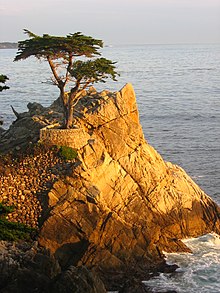This article needs additional citations for verification. (October 2008) |


Cypress is the name applied to many plants in the cypress family Cupressaceae, which is a conifer of northern temperate regions. Most cypress species are trees, while a few are shrubs.
Cupressus sempervirens is famous for its longevity, and has been a popular garden plant for thousands of years.
The word cypress is derived from Old French cipres, which was imported from Latin cypressus the latinisation of the Greek κυπάρισσος (kyparissos).[1][2]
- African cypress (Widdringtonia species)
- Bald, pond, and Montezuma cypresses (Taxodium species, native to North America)
- Chinese swamp cypress (Glyptostrobus pensilis)
- Cordilleran cypress (Austrocedrus chilensis)
- Cypress (Callitropsis species)
- Cypress (Cupressus species)
- Cypress-pines (Actinostrobus species)
- Cypress-pines (Callitris species)
- False cypress (Chamaecyparis species)
- Fujian cypress (Fokienia hodginsii)
- Guaitecas cypress (Pilgerodendron uviferum)
- Patagonian cypress (Fitzroya cupressoides)
- Siberian cypress (Microbiota decussata)
The Cupressaceae family also contains 13–16 other genera (not listed above) that do not bear cypress in their common names.
The word cypress is also used as a descriptor for the angiosperm vine in the bindweed family Convolvulaceae, known as the cypress vine (Ipomoea quamoclit).
The plant called "summer cypress" is Bassia scoparia (Amaranthaceae).
Allergenic Potential
editHighly allergenic species of cypress with an OPALS allergy scale rating of 8 or higher include: Taxodium, Cupressus, Callitris, Chamaecyparis, Asutrocedrus males, and Widdringtonia males and monoecious. Species of cypress with very low potential for causing allergies (an OPALS allergy scale rating of 2 or lower) include: Austrocedrus females and Widdringtonia females.[3]
See also
editReferences
edit- ^ κυπάρισσος, Henry George Liddell, Robert Scott, A Greek-English Lexicon, on Perseus Digital Library
- ^ http://www.etymonline.com/index.php?term=cypress
- ^ Ogren, Thomas (2015). The Allergy-Fighting Garden. Berkeley, CA: Ten Speed Press. ISBN 9781607744917.